Explore Bologna, Italy's lively university town with historic charm, renowned cuisine, and vibrant culture in its sprawling Centro Storico.
Read more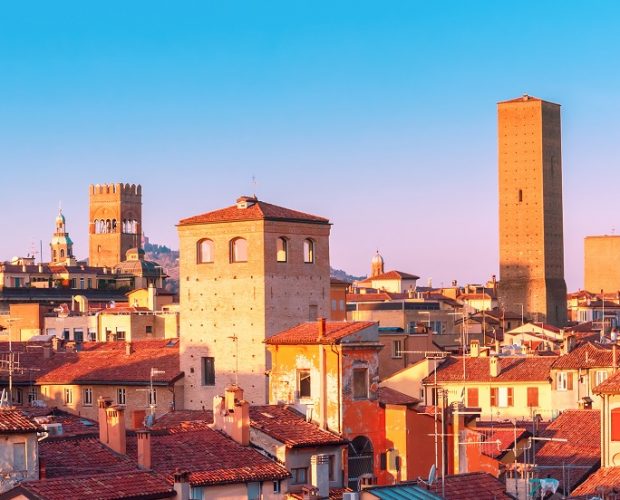
EXPLORE ALL OUR EMILIA-ROMAGNA WINE REGIONS GUIDE
Last updated: May 23, 2024
It’s tough to talk about Lambrusco – Italy’s seminal sparkling red wine, now the butt of jokes from here to Shanghai – and not snigger. Decades of bastardization, largely from the Italians themselves, have done the category’s reputation immense damage; there is also much confusion surrounding Lambrusco and the geographical origins of this age-old style. The term Lambrusco encompasses more than 60 varieties that, although genetically similar, are considered individual grapes. Additionally, the tradition of Lambrusco originated in the plains of Emilia Romagna (with Modena still producing the most vivid wines). However, many grapes classified under this umbrella term are also cultivated in Lombardy, Piedmont, and even Basilicata in the south.
Naysayers will tell you that Lambrusco is a one-trick frothy pony, but they’re wrong. The dichotomy between authentic, high-quality Lambrusco and its bargain-basement cousin is mind-blowing. To quote wine buyer Steve Daniel, the latter is “to syrupy-sweet for its own good,” made via the charmat (tank) method in industrial conditions. Exporters shipped this cheap-and-cheerful interpretation of Lambrusco to the US and northern Europe in vast quantities during the 1970s and 1980s. Yet, while it generated considerable revenue for Italian producers, it also ironically alienated a more discerning audience who came to regard Lambrusco as fizzy pop. After that, consumers turned away in their droves.
The former, however, can be mesmerizing: a delicious, low-alcohol sparkling wine that is both dry (secco) and perfect with rich Emilia Romagna cuisine. Of course, there is still some confusion, and the mass-produced article dwarfs the number of traditional method examples. But that’s a feeble argument for not giving Lambrusco a second chance.
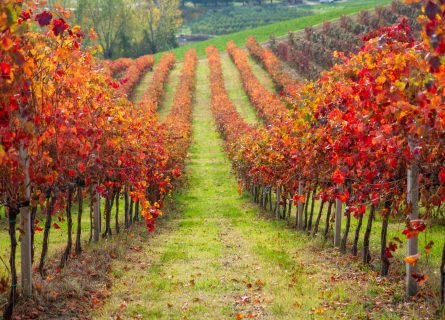
Lambrusco is one of the wine world’s great paradoxes: a highly diverse category commonly pigeonholed as Italy’s “Coca-Cola” grape. Yet, multiple regions—and appellations—are dedicated to this broad family of grape varieties and wine styles, most famously in the vineyards of Emilia-Romagna, northeast Italy. But there is also a longstanding tradition of making red bubbly in Lombardy and Piedmont—Lambrusco Maestri is even found in Argentina and Australia, where it has adapted to these hotter climates with surprising ease.
Indeed, Lambrusco grapes’ enduring popularity ( in viticultural terms), particularly Lambrusco Maestri and Sorbara, is partially due to their generous yields and robust character – cultivating Lambrusco is rarely challenging. The IGT/DOC regulations reflect this with their hyper-liberal approach to grape yields, resulting in bountiful harvests that would make a Burgundian blush with embarrassment.
According to the IGT Emilia Lambrusco, for example, farmers can harvest up to 232 hectoliters of grapes per hectare; the maximum permitted yield in Le Montrachet is 48 hL per hectare. The difference is staggering.
Adaptability to Various Soils
The Lambrusco family is also highly flexible and adaptable regarding soil suitability. It is said that Lambrusco Grasparossa thrives on clay-silt terroir, which is a common feature of Castelvetro, a subregion found to the south of Modena. However, the fertile, alluvial material ubiquitous to the River Po and its surrounding valley is heavily planted to different Lambrusco varieties – one of the reasons why abundant yields are the norm.
In the vineyards of Lambrusco Montovano DOC in Lombardy, growers (typically) blend a mixture of Viadanese, Maestri, Marani, and/or Salamino to produce textbook Lambrusco: low-alcohol and gently frothy red wine that may also incorporate a touch of Fortana, Sorbara and/or Grasparossa. It is perhaps the most consistent source of premium Lambrusco wines outside Emilia-Romagna today.
Of course, it cannot compete with the volumes made in its larger neighbor. There are five principal Lambrusco appellations in Emilia-Romagna: Lambrusco Grasparossa di Castelvetro, Lambrusco Salamino di Santa Croce, Lambrusco di Sorbara, Modena and Reggiano DOCs. Soils are predominately composed of silt, clay, and sand; climatic conditions range from mildly continental to humid subtropical in the coastal exterior. According to the authorities, just over 8400 hectares are planted to Lambrusco Salamino, Grasparossa, and Sorbara in Emilia-Romagna, the three most populous varieties.
However, many critics regard the wines of Modena DOC, above all Lambrusco Sorbara, as head and shoulders above their rivals. In truth, there is something undeniably appetizing about Modena’s bright – and balanced – fizzy reds, bursting with red-berry flavors and ripe acidity. However, Modena does not have a monopoly on high-quality Lambrusco wines. There is fierce competition from Reggiano and Lambrusco di Sorbara, the latter producing a growing volume of very fragrant and floral sparkling wine, increasingly made into a rosé style.
Lambrusco is often misrepresented as a homogeneous wine category: gently effervescent, darkly colored, and cheap. Yet, look beyond the mass of fizzy plonk sold to supermarkets worldwide. You’ll discover a broad variety of expressions and styles, ranging from sickly sweet charmat to single-vineyard bottlings that are extremely dry. While the critical mass of Lambrusco grapes is converted into a medium-sweet, purple-colored wine and carbonated, this is of little interest to oenophiles and wine lovers. Instead, let’s focus on the appealing rosés, traditional method cuvées, and even the occasional white blends that confound expectations.
One of the easiest ways of differentiating Lambrusco is the choice of grape variety – or, indeed, varieties! As a general rule, the purple-black flagship wines, poured in Italian restaurants since time immemorial, contain a large percentage of Grasparossa or Salamino – both varieties are packed full of coloring pigments and flavor compounds. Sorbara, meanwhile, tends to yield wines with a relatively pale hue and seductive red fruit; the most aromatic and moreish sparkling wine imaginable is Lambrusco di Sorbara rosé. It can rival pink Champagne’s finesse and uncommon delicacy when produced in a dry, traditional method.
Much also depends, though, on the winemaking. As any critic will tell you, there is a world of difference between carbonated plonk, quickly and cheaply made by the giant co-operatives, and the premium labels of Fangareggi, Rinaldini, and Cantina della Volta. The latter focuses heavily on the traditional winemaking method: base wines undergo a secondary fermentation in the bottle, releasing CO2 into the wine as a byproduct of converting sugar to alcohol. However, unlike Champagne, producers rarely age Lambrusco for more than 48 months before disgorgement, although some notable exceptions exist.
Resurgence of Méthode Ancestrale
Meanwhile, the méthode ancestrale is enjoying something of a resurgence in Emilia-Romagna. Historically known as the méthode rurale, this is a very old precursor to the traditional method: it involves a continuation of the primary fermentation in bottle, releasing a modest amount of carbon dioxide into the wine. Some winemakers elect to sell their méthode ancestrale labels without disgorgement, marketing a very cloudy wine style that appeals to hipster sommeliers and can horrify, ironically, the traditionalists. Producers create both sweet and dry styles; they chill the former before the termination of primary fermentation, thereby retaining some residual sugar in the wine.
Nevertheless, the tank method is king in Emilia-Romagna. Simply put, the base wines undergo a secondary vinification in large tanks, typically stainless steel, before they are chilled, filtered, and bottled. Many good-value Lambrusco wines are made this way: straightforwardly fruity and very pleasant to drink. But there is a great deal of dross as well.
Any overview of Lambrusco used to begin or conclude with a lament that the industry had shot itself in the foot by exporting large volumes of tawdry, over-sweetened fizzy plonk. This style is hardly in vogue in 2024! Indeed, before the 1980s, Lambrusco was ubiquitous in restaurant cellars across the US, loved and adored by millions of consumers. Unfortunately, its purveyors became greedy and cynically lazy: the backlash that followed was an inevitable – and understandable – reaction to the inflated yields and low-grade winemaking that almost destroyed Lambrusco’s good name.
Today, however, there are clear signs that oenophiles are willing to overlook Lambrusco’s past mistakes and give the category a chance to redeem itself. The lighter styles, in particular, are subject to growing demand worldwide. At the same time, overall exports are buoyant in several key and developing markets, including the US, the Baltic States, and South America.
Perhaps this is a reward for the tireless work of leading producers like Baldini and Francesco Bellei after years of mistrust and apathy, or perhaps wine lovers are finally paying heed to critics and influencers who have been imploring them to experience the best of this underrated and diverse sparkling wine style. Whatever has prompted the growing recognition given to premium Lambrusco, it is certainly a welcome trend.
Quality and Value of Modern Lambrusco
Charmat and carbonated versions remain in circulation, for sure. But there is a growing awareness that top-quality Lambrusco, be it dry or sweet, red or pink, can titillate like few other sparkling wines. It is fresh, fruity, and utterly delicious, lifted by its lively acidity and moderate alcohol. It can match almost any Italian food and seldom costs more than $25. Nothing will ever displace Champagne (or indeed Franciacorta) from its throne, yet canny consumers know that Lambrusco offers far better value and is more suited to informal occasions. So our advice is simple: forget your prejudices – just try it.
Malbo Gentile is a dark-skinned grape from Emilia-Romagna, Italy, used in blending for sparkling Lambrusco and for varietal wines. Thriving at high altitudes, it produces sweet and dry wines with rich black fruit flavors and notable tannins, often softened by oak aging.
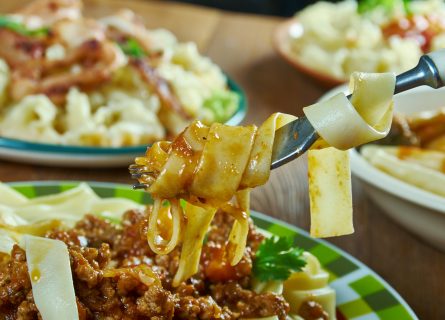
Lambrusco is the ultimate food wine: versatile, inexpensive, and readily available. Indeed, there is a bottle for every occasion and context. Thus, lighter and drier styles work as an aperitif. Full-bodied Lambrusco Salamino cuts through the richness of Ragù alla Bolognese with aplomb, while pretty pink Sobara, off-dry, is sublime with Zuppa Inglese or Torta di riso. There really is no need to reach for anything else.

Explore Bologna, Italy's lively university town with historic charm, renowned cuisine, and vibrant culture in its sprawling Centro Storico.
Read more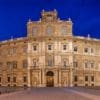
Explore Modena's Culinary Delights and Automotive Heritage. Discover the World's Best Balsamic Vinegar and Ferrari's Birthplace.
Read more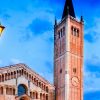
Discover Parma, the culinary heart of Italy, where Prosciutto and Parmigiano Reggiano reign supreme. Explore its rich history and artistic heritage.
Read more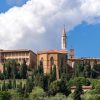
Discover Pienza's Renaissance Charm and Rich History in the Heart of Tuscany's Val d'Orcia. Explore Etruscan Roots, Renaissance Architecture, and Timeless Beauty.
Read moreIf you would like us to customize an exclusive luxury tour, contact us and let us know your travel plans. We offer luxury food and wine tours for private groups of a minimum two guests. In addition, all of our private, chauffeured tours are available year-round upon request.

